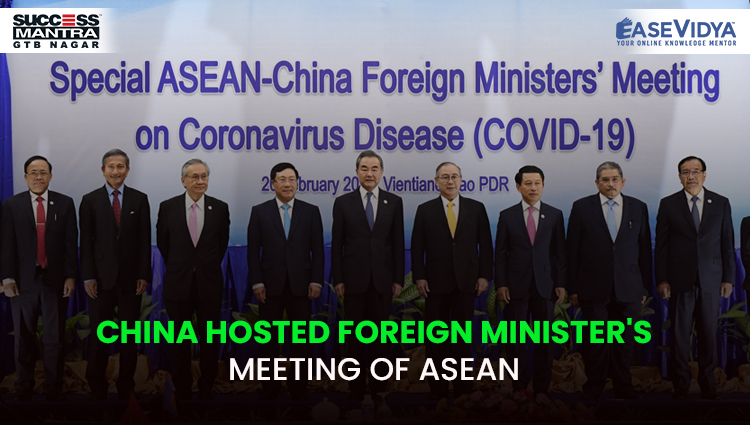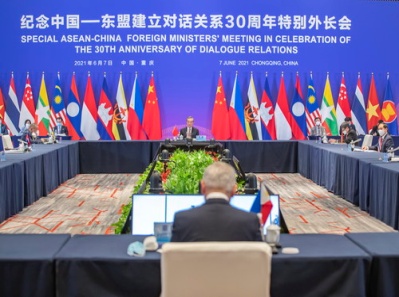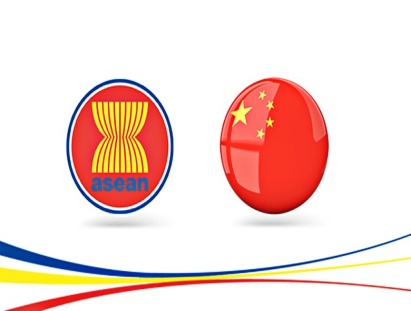
CHINA HOSTED FOREIGN MINISTER S MEETING OF ASEAN
CHINA HOSTED FOREIGN MINISTER'S MEETING OF ASEAN

- Recently, China hosted a meeting of foreign ministers from the 10 Association of Southeast Asian Nations (ASEAN) The meeting marks the 30th anniversary of China-ASEAN dialogue. With this meeting China looks to deepen its economic ties with the region as well as push back the renewed effort at regional engagement from the US, as well as from the QUAD (Quadrilateral Framework) grouping. QUAD earlier this year came out with a regional vaccine initiative.
- China’s Stand: China’s Cultural Diplomacy: Reiterated that China and ASEAN should jointly carry forward Asian values in a subtle dig at the West. China in 2014 had put forward the idea that it was for “Asian people to uphold Asia’s security”. China offered ASEAN countries its vaccines as well as closer cooperation on joint vaccine development and production.
- Maritime Security & Disputes: China called for considering the lifting of China-ASEAN ties to comprehensive strategic partnership and strives for an early agreement on a code of conduct in the South China Sea. China is banking on deep economic links to both offset maritime disputes and the push among some ASEAN countries for closer defence ties with the US amid their concerns about China’s growing military footprint in the South China Sea.
REGIONAL COMPREHENSIVE ECONOMIC PARTNERSHIP (RCEP)
China pushed for the early implementation of the Regional Comprehensive Economic Partnership (RCEP), which was signed by China, ASEAN countries, Japan, South Korea, Australia and New Zealand in November 2020. India withdrew from the RCEP largely because of concerns it would open it up to Chinese goods amid an already wide trade imbalance with China, and the failure of the agreement to adequately open up to services.
The Regional Comprehensive Economic Partnership (RCEP) is a mega-regional economic agreement being negotiated since 2012, between ASEAN and Free Trade Agreement (FTA) member partners.
Goals: Boost economic growth and equitable economic development, advance economic cooperation and broaden and deepen integration in the region through the RCEP. It aims to cover the trade in goods and services, investment, economic and technical cooperation, intellectual property and dispute resolution. In 2017, the 16 prospective signatories (including India) accounted for a population of 3.4 billion people with a combined gross domestic product (GDP) of US$ 21.4 trillion, about half of the world population and 39 percent of the world's GDP.
History: Countries in the East Asia region have thriving trade and economic relations with each other through free trade agreements. The Association of Southeast Asian Nations (ASEAN) (ASEAN+1 FTAs) has free trade agreements with six partners namely, The People's Republic of China (ACFTA), Republic of Korea (AKFTA), Japan (AJCEP), India (AIFTA), Australia and New Zealand (AANZFTA). To broaden and deepen the engagement among parties and to enhance parties' participation in the economic development of the region, the leaders of the 16 participating countries established the RCEP. The RCEP was built upon the existing ASEAN+1 FTAs with the spirit to strengthen economic linkages and to enhance trade and investment-related activities as well as to contribute to minimising development gap among the parties.
The RCEP negotiations were launched between the Ten ASEAN member states and six ASEAN FTA partners during the 21st ASEAN Summit and related summits in Phnom Penh, Cambodia in November 2012
ASEAN'S IMPORTANCE FOR CHINA

ASEAN plays a key role in Chinese economic and strategic interests. The region straddles vital sea lanes of communication that represent China’s access to the global market, including vital imports of Middle Eastern oil. Economically entwined with China, the relatively small nations of the region also offer ample opportunities for China to advance its influence and weaken what Chinese strategists perceive as a US (Presence of US) engineered chain of encirclement around the Chinese mainland.
ASEAN and India: Traditionally the basis of India-ASEAN ties has been trade and people-to-people ties due to shared historical and cultural roots, a more recent and urgent area of convergence has been balancing China’s rise.
In 2020, 17th ASEAN-India Virtual Summit was held. The 8th East Asia Summit Economic Ministers’ Meeting (EAS-EMM) was also held in 2020. It comprises the ten member states of the ASEAN, along with 8 other countries namely Australia, China, Japan, India, New Zealand, the Republic of Korea, Russia and the USA. Both India and ASEAN aim to establish rules-based security architecture for peaceful development in the region, in contrast to China’s aggressive policies. Like India, several ASEAN members such as Vietnam, the Philippines, Malaysia, and Brunei have territorial disputes with China, the China factor does form an important component of the relationship. India in 2014 reinvigorated the Look East policy into Act East, with a more strategic outlook than its previous incarnation, focusing on engagement not just with Southeast Asian countries but also those in the Pacific. The main focus of the Act East policy is on enhancing connectivity between India and South East Asia.
ABOUT THE ASEAN
It is a regional grouping that promotes economic, political, and security cooperation. It was established in August 1967 in Bangkok, Thailand with the signing of the ASEAN Declaration (Bangkok Declaration) by the founding fathers of ASEAN, namely Indonesia, Malaysia, Philippines, Singapore and Thailand. Its chairmanship rotates annually, based on the alphabetical order of the English names of Member States. ASEAN countries have a total population of 650 million people and a combined Gross Domestic Product (GDP) of USD 2.8 trillion. It is India’s 4th largest trading partner with about USD 86.9 billion in trade.
Members: Brunei, Cambodia, Indonesia, Laos, Malaysia, Myanmar, the Philippines, Singapore, Thailand, and Vietnam.
CONCLUSION
With China frequently displaying the intention as well as capability to challenge India, as seen in the Doklam standoff, it is pertinent that India finds more like-minded nations interested in working together to protect regional peace and stability. In this context, ASEAN fits the bill perfectly. ASEAN can also spur rapid growth of India’s underdeveloped northeastern region if linkages that enable movement of people and goods could be established quickly. But in order to do that, India must focus on speeding up connectivity projects and addressing its uneven balance of trade with ASEAN nations.
TEST YOURSELF
Q.1 Recently, which of the following countries have hosted a meeting of foreign ministers from the 10 Association of Southeast Asian Nations (ASEAN) countries?
- United States of America
- China: ANSWER
- India
- Myanmar
Q.2 Consider the given statements & state which of the following is incorrect in the reference to the above mentioned passage?
- China offered ASEAN countries its vaccines as well as closer cooperation on joint vaccine development and production.
- China looks to deepen its economic ties with the region as well as push back the renewed effort at regional engagement from the US, as well as from the North Atlantic Treaty Organization (NATO).
- China in 2014 had put forward the idea that ASEAN was for “Asian people to uphold Asia’s security”.
- Only II follows: ANSWER
- I & III follows
- II & III follows
- None of the above
Q.3 Consider the following statement with reference to Regional Comprehensive Economic Partnership (RCEP) and state which of the following is correct?
- RCEP is viewed as an alternative to the Trans-Pacific Partnership (TPP).
- Regional Comprehensive Economic Partnership (RCEP) is a proposed free trade agreement (FTA) between the ten member states of the Association of Southeast Asian Nations (ASEAN) and the six states with which ASEAN has existing free trade agreements.
- Only I follows
- Only II follows
- Both I & II follows: ANSWER
- Neither I nor II
Q.4 Which of the following statements is incorrect in the reference to the Association of South-East Asian Nations (ASEAN) members?
- Indonesia has the highest population among the ASEAN members.
- Singapore has the highest Per Capita GDP among the ASEAN members.
- Cambodia has the lowest nominal GDP among the ASEAN members: ANSWER
- Brunei has the lowest population among the ASEAN members.
Q.5 Consider the given statements & state which of the following is the objectives of the ASEAN?
- To increase competition among the members of countries for better products.
- To integrate the economies of the region to make region more attractive for investors
- To promote economic cooperation in the South East Asia and ensure economic stability in the region.
- Only I follows
- Only I & III follows
- Only II & III follows: ANSWER
- None of the following












0 Comment